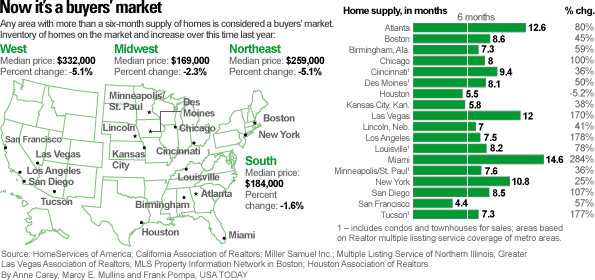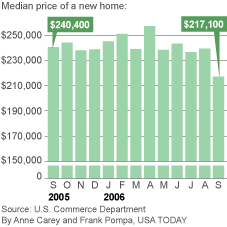Noelle Knox
USA Today
Then: San Diego’s housing market was so hot that the town house next to Jeff Cruce’s was flipped from buyer to seller three times in three years. The owners, who never moved in, didn’t even need to put up a “For Sale” sign.
Now: Since August, Cruce and seven of his neighbors have put their town houses on the market (that’s nearly 20% of the units in the complex). All have cut their prices, including Cruce, who chopped his price last month by $30,000 to $559,000. Not one has received an offer yet. Each time one owner would lower the asking price, it put pressure on the others to follow, says Cruce, 38, a salesman who’s moving to Atlanta.
That domino effect, rippling through neighborhoods across the country, pushed down the nation’s median home price in September by the largest amount on record, the National Association of Realtors (NAR) said Wednesday.
The median price for a single-family home slipped 2.5% from September last year to $219,800, the sharpest annual drop since the NAR began tracking the data in 1969. The median-priced condominium fell 2.8% to $219,800, the fourth annual decline in a row.
At the same time, the volume of home sales fell for the sixth straight month, tumbling 14% in September compared with a year ago.
In the softest real estate markets, sellers are waking up to the harsh reality that they can’t get anywhere near what their neighbors sold their homes for last year. So they’re grudgingly reducing their asking prices and offering to pay closing costs.
At the same time, many buyers, emboldened by the transformed market, are low-balling sellers and getting deals they couldn’t have imagined last year.
Just ask Sevan Derderian and Reggie Johnson.
In 2004, Derderian bought a house in Las Vegas as an investment for $281,000. He found tenants, but he kicked them out after 10 months because their rent was always late.
“I found that it’s really hard to be a landlord from a state or two away,” says Derderian, 43, a salesman in Los Angeles. He held onto the property for another year, hoping prices would keep going up. Once the market turned south, though, he panicked.
He listed the house in the summer for $305,000. Having owned real estate only during boom years, he assumed it would sell in about a week. After a month, he cut the price to $289,900. Another week went by. He offered to pay nearly $9,000 toward a buyer’s closing costs.
Then along came Johnson, a 38-year-old truck driver, who snapped up the house and boasts, “I got a great deal.”
Derderian, meantime, lost about $25,000 from paying the mortgage on an empty home.
Where’s the bottom?
That’s a risk confronting sellers in 56 metro areas, including Las Vegas, San Diego, Phoenix, New York and Miami, that are expected to suffer annual price drops, according to a study this month by Moody’s Economy.com.
Prices in a few markets, such as Las Vegas and Portland, Ore., won’t bottom out until 2009, the study projected, and in many areas prices will stay flat through the end of the decade. (For a full list, click here.)
“It was surprising just how quickly the market seemed to turn,” says Mark Zandi, chief economist for Economy.com. “It was like, boom, boom, bust. It was like, ‘What happened?’ The psychology in the marketplace unraveled very rapidly.”
In fact, about half of American homeowners who thought of selling their homes in the past year have delayed putting their homes on the market, according to a USA TODAY/Gallup poll conducted this month.
And roughly one-third of those who had considered selling have abandoned the idea. (The poll of 1,007 adults has a margin of error of plus or minus 3 percentage points.)
Of course, home prices aren’t going to fall in every market. About one-third of the nation is expected to see moderate price growth for the rest of the year. Those areas include Dallas, Austin, Newark, Del., and Birmingham, Ala. — areas where prices didn’t test the stratosphere during the boom.
Even in the once-sizzling markets, homeowners and investors who bought their properties more than two years ago should still see modest gains if they sell in the current market.
Relocating can be costly
But it’s clearly a buyer’s market now. The number of homes for sale has bulged to a 7.3-month supply compared with 4.6 months last September. The backlog of homes for sale is thickest in the areas that witnessed the fastest price growth and investor activity.
“It’s frustrating,” says Cindy Holliday, a high school math teacher who recently took a job in Chicago. “Homes were selling for so much more a few months ago, and now nothing’s selling at all.”
Holliday and her husband were house hunting in Chicago in June when they put their home in Ocala, Fla., up for sale.
“Before we put our house on the market, houses were selling so fast we didn’t think we’d have a problem selling our house at all,” says Holliday, 31.
“When we got back down there (to Ocala), just about every other house on our street was for sale. It was very depressing.”
Though their house probably would have fetched nearly $200,000 earlier this year, they listed it at $179,000. A couple of weeks ago, they trimmed the price to $174,500.
But it’s no easier for sellers in Chicago, says Javier Diaz. He’s made several profitable real estate investments, but the three-unit apartment building he bought in Chicago earlier this year wasn’t one of them.
“I figured this year the property would go up 30 or 40 grand, but that didn’t happen,” says Diaz, 28.
He put it up for sale in September, asking $415,000. He’s already cut the price twice, to $375,000. That’s less than he owes on his loan, which means that if Diaz sells at that price, he’ll have to pull $5,000 out of his own pocket to pay the bank.
Being a mortgage broker, Diaz knows some investors who used their home equity like debit cards. He says of the quick decline in real estate, “It’s coming like a culture shock to many.”
‘Everyone was doing it’
Vicki di Bernardo agrees. “It taught us a lesson,” she says of the downturn in Las Vegas. “It was a little risky, but we got caught up in it. Everyone was doing it. … (Now) everyone is very, very nervous here about the real estate market.”
She recalls buying a single-family home in the Las Vegas suburb of Summerlin as an investment in 2003.
“We were on a huge waiting list, and our names came up, and we had to go in with a check and give it to them within a couple of hours or they’d go to the next on the list.”
She rented the house out for two years. But when her tenants moved out in February, she put it on the market for $574,000.
“In the first three months, we didn’t have one showing — not one,” says di Bernardo, 60, who works in human resources. At the end of May, she dropped the price to $519,000. Three weeks later, she came down to $499,000. Even then, only looky-loos came by.
“There was so much inventory” on the market, di Bernardo recalls. “So many builders had offered huge incentives, like no mortgage payments for 12 months or a swimming pool. We had it on the market for $479,000 when an offer came in at $460,000.”
She grabbed it. She still made $175,000, but that’s about $100,000 less than she’d have made if she sold last year.
Desperate builders a problem
Builders, with no emotional attachment to their homes, have become one of the biggest financial threats to individual sellers. New-home sales are down 16% this year. Building permits for single-family homes are off by 20%. Faced with a huge number of cancellations, builders began trying to lure buyers with eye-catching deals, such as free vacations, media rooms and landscaping.
That’s what’s hurting Bryan Rauch. In January, he bought a home in Anthem, Ariz., where Pulte Homes is offering a slew of incentives, including advice from re-sale experts to help buyers fix up and sell their current homes.
“The plan was to renovate it and flip it,” says Rauch, 37, a nurse-turned-real estate-investor.
He put the home back on the market in February, at $284,000, then lowered the price repeatedly until he hit $270,000. Still no buyers. After six months, he rented it out at a $500-a-month loss.
“The problem is the builder is giving away homes,” Rauch says. “Properties like this are now selling for the low $200s.”
But Rauch needs to cut his losses. So he’s putting the home back on the market at $260,000 and crossing his fingers — like a lot of other sellers around the country.













